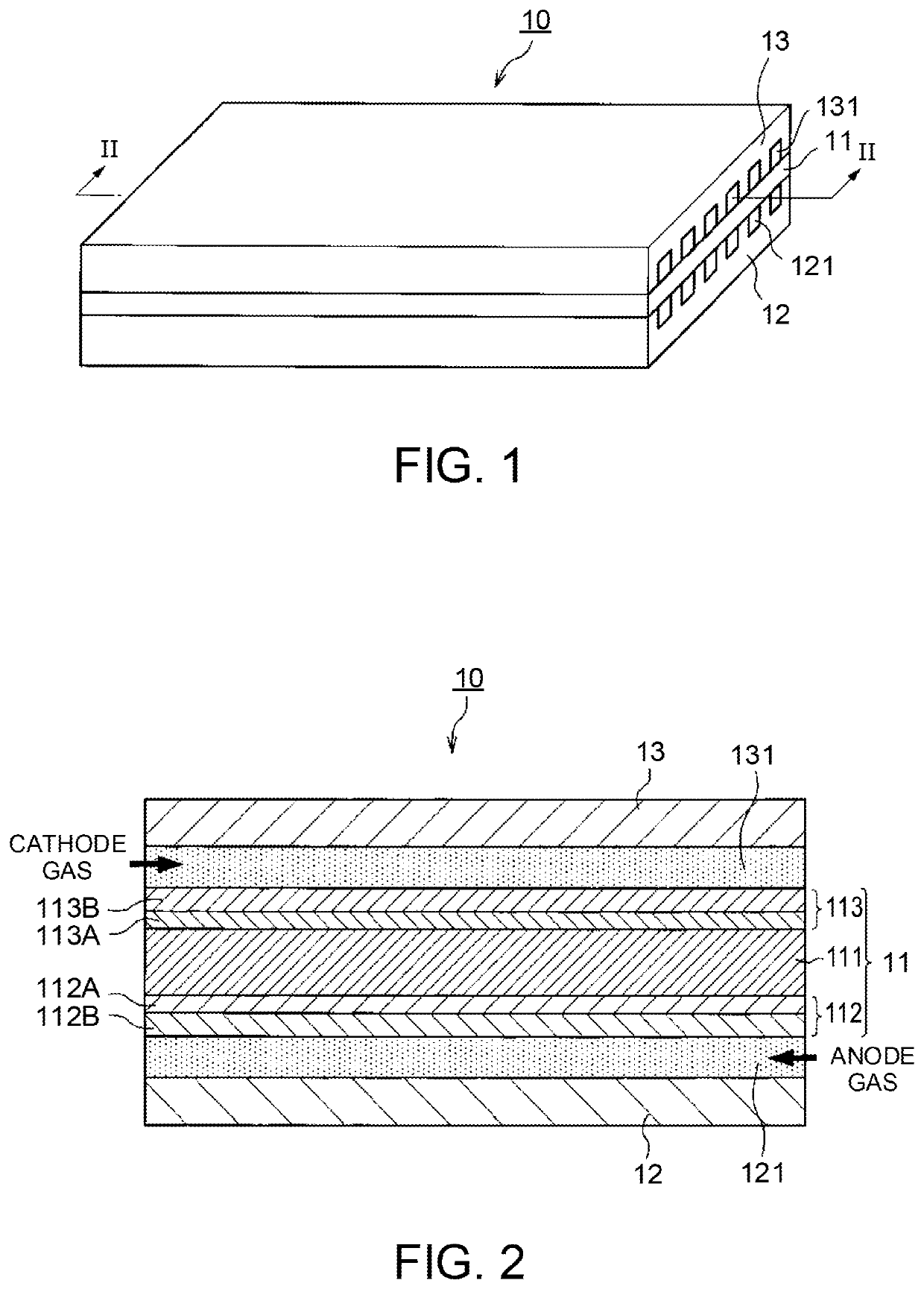Catalyst deterioration recovery device and catalyst deterioration recovery method
a recovery device and catalyst technology, applied in the direction of solid electrolyte fuel cells, fuel cells, electrical equipment, etc., can solve the problems of fuel gas containing oxygen and deteriorating an electrolyte membrane, and achieve the effect of suppressing the deterioration of an electrolyte membran
- Summary
- Abstract
- Description
- Claims
- Application Information
AI Technical Summary
Benefits of technology
Problems solved by technology
Method used
Image
Examples
first embodiment
[0024]FIGS. 1 and 2 are diagrams explaining the configuration of a fuel cell 10 according to an embodiment of the present invention. FIG. 1 is a perspective diagram illustrating the fuel cell 10 and FIG. 2 is a cross-sectional diagram viewed from the II-II line of the fuel cell 10 illustrated in FIG. 1.
[0025]The fuel cell 10 includes a membrane electrode assembly (MEA) 11 and anode and cathode separators 12 and 13 that are arranged to sandwich the MEA 11 therebetween.
[0026]The MEA 11 is configured to include an electrolyte membrane 111, an anode electrode 112, and a cathode electrode 113. The MEA 11 includes the anode electrode 112 on one side and the cathode electrode 113 on the other side of the electrolyte membrane 111.
[0027]The electrolyte membrane 111 is an ion exchange membrane having proton conductivity formed of fluorinated resin. The electrolyte membrane 111 shows good electrical conductivity in a wet / dry state.
[0028]The anode electrode 112 includes a catalyst layer 112A an...
second embodiment
[0118]The present embodiment is similar to the first embodiment in light of the basic thinking of the catalyst recovery process of cross-leaking oxygen toward the anode, but is different from the first embodiment in light of a process for cross-leaking oxygen.
[0119]The first embodiment increases the partial pressure difference dP of oxygen so as to increase the permeation flux F of oxygen. On the contrary, the present embodiment increases the permeation coefficient k of oxygen so as to increase the permeation flux F of oxygen. Hereinafter, a method of increasing the permeation coefficient k will be explained.
[0120]FIG. 12 illustrates a relationship between the oxygen permeation coefficient of the electrolyte membrane 111 and the temperature and water content of the electrolyte membrane 111. As illustrated in FIG. 12, the electrolyte membrane 111 has a characteristic that the oxygen permeation coefficient grows larger as the temperature becomes higher. Moreover, as illustrated in FIG...
PUM
| Property | Measurement | Unit |
|---|---|---|
| oxidation reaction rate | aaaaa | aaaaa |
| oxidation reaction rate | aaaaa | aaaaa |
| adsorption | aaaaa | aaaaa |
Abstract
Description
Claims
Application Information
 Login to View More
Login to View More - R&D
- Intellectual Property
- Life Sciences
- Materials
- Tech Scout
- Unparalleled Data Quality
- Higher Quality Content
- 60% Fewer Hallucinations
Browse by: Latest US Patents, China's latest patents, Technical Efficacy Thesaurus, Application Domain, Technology Topic, Popular Technical Reports.
© 2025 PatSnap. All rights reserved.Legal|Privacy policy|Modern Slavery Act Transparency Statement|Sitemap|About US| Contact US: help@patsnap.com



